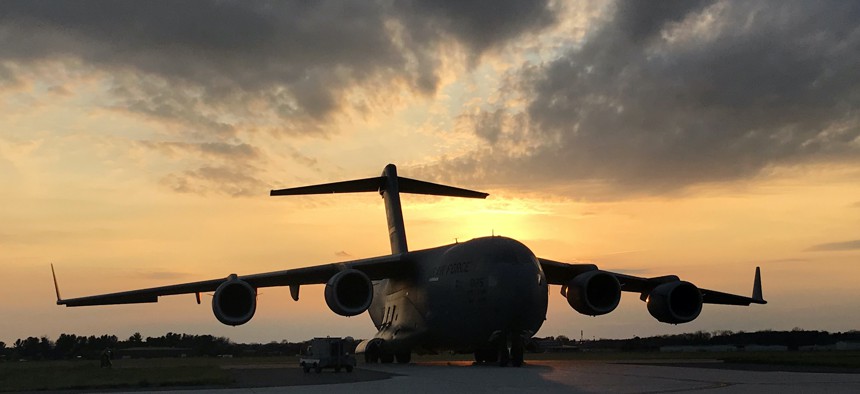
A C-17 Globemaster III assigned to the 305th Air Mobility Wing is parked on the flight line at Joint Base McGuire-Dix-Lakehurst, N.J., April 5, 2020. U.S. Air Force / Maj. Brian Wagner
New Budget Would Modify Planes, Pursue Hybrid Vehicles To Tackle Climate Change
The Pentagon’s 2023 proposal aims to reduce C-130 drag, modify KC-135 engines, and design a fuel-sipping airframe.
The Pentagon’s fiscal 2023 budget request is a “turning point” for the military’s efforts to fight climate change, the Defense Department’s top climate officer said Tuesday.
The request includes millions of dollars to prepare bases for extreme weather, make warplanes more fuel-efficient, and more.
“The budget advances our core warfighting mission while mitigating the climate risk to the force and reducing the department’s own contribution to greenhouse gas emissions,” Joe Bryan, the chief sustainability officer, told reporters. “It is an important step forward and again, I think represents a turning point in how the department considers climate risk.”
The budget request includes $42.5 million to install drag-reducing devices on C-130s, C-135s, and C-17As, Bryan said. By reducing the planes’ appetite for fuel, they will reduce environmental impact and relieve pressure on the military supply system.
Another $31.5 million will modify KC-135 and C-17 engines to reduce the amount of fuel used to fly, Bryan said, while $55 million will fund the development of a full-scale blended wing body aircraft that is significantly more fuel efficient than traditional airframes.
The military is also pursuing more fuel efficiency on the ground, where it has the largest federal fleet of non-tactical vehicles outside the U.S. Postal Service, Bryan said. The Pentagon is asking for $30 million to work on hybrid electric power systems for military vehicles such as the Joint Light Tactical Vehicle, the Family of Medium Tactical Vehicles and the Medium Tactical Vehicle Replacement.
The department also proposes to spend $2 billion to make its installations more resilient to climate change, Bryan said.
The budget begins to fund some of the ambitious goals outlined last year by the Climate Risk Analysis, which evaluates the threats posed by climate change, and the Climate Adaptation Plan, which includes goals for how the military can operate in a more extreme climate. President Joe Biden also released an executive order on addressing climate change shortly after taking office in January 2021 that directed military leadership to consider climate change in their planning.
Bryan said this year’s budget request is a downpayment towards following through on the priorities and goals laid out in those documents.
“This is a super-aggressive budget,” Bryan said. “This is again a turning point in the way the department considers and invests in the kind of capabilities that are going to make us more resilient to climate impacts, more lethal, and more capable in the war fight by reducing logistics requirements and by increasing the capability of our platforms.”




